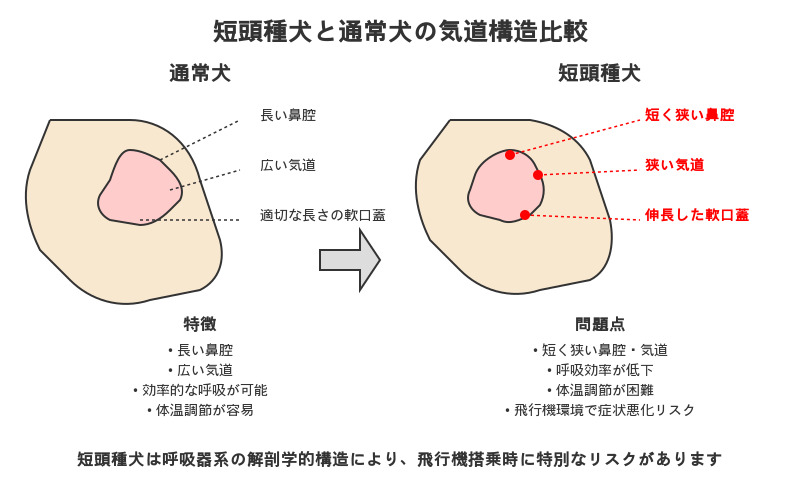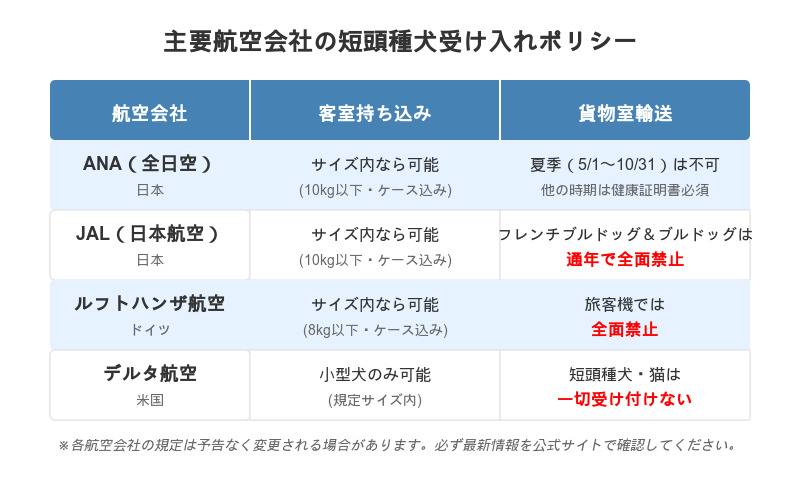Introduction: Risks and Measures for Short Breed Dogs and Airplane Boarding
Pugs and French bulldogs.Short-breed dogs (dogs with flat noses)Many owners are considering taking their But, "Can short-horned breeds fly?" Which airlines will accept them? How can we keep them safe in the plane? What is the safest way to keep them safe in the cabin?
Due to their unique body structure, short-breed dogs pose special risks when traveling by air.U.S. Department of Transportation statistics show that about half of all dogs killed during air transportation are short-hornedThere are also reports that it was

Before flying, try to start with a short drive to get your dog accustomed to the move. It is also important to consult your veterinarian for specific advice tailored to your dog's physical condition and condition!
*The information in this article is current as of March 2025. Please be sure to check the official website for the latest information, as the regulations of each airline are subject to change.

Short-headed dogs have flat faces, but their structure makes it difficult for them to breathe. That's why they need special care when traveling by plane!
This article provides a thorough explanation of the latest rules, precautions, and specific preparation methods for air travel with short-breed dogs, using professional data and actual examples. Please read to the end in order to realize air travel with your dog's safety as the top priority.
1. medical reasons why short-breed dogs should be careful on airplanes
Risks posed by the anatomy of short-breed dogs
Short-headed dogs (brachycephalic breeds) require special attention when boarding airplanes due to their distinctive facial structure. Understand why the common anatomical features of these breeds pose a risk in the airplane environment.
Respiratory characteristics of short-breed dogs:
- Nose and airways are short and narrow, so breathing efficiency is low even under normal conditions
- Soft palate is long and may partially obstruct the airway
- Narrow nasal passages and restricted airflow
- In many cases, the trachea is thinner than normal.
These characteristics make short-breed dogs "theBrachycephalic airway syndrome (BOAS)They are more likely to have a respiratory problem called

Compared to the average dog, short-breed dogs have a narrower pathway for air intake. This is a problem in the special environment of airplanes.

Effects of the airplane environment on short-breed dogs.
The environment in airplanes places a special strain on the respiratory system of short-breed dogs:
– Decrease in atmospheric pressure: In-flight air pressure is 20-251 TP3T lower than on the ground, and oxygen levels are also lower.
– Temperature change: Temperature fluctuations can occur, especially in the cargo hold, and short-breed dogs are not good at regulating their body temperature.
– Stress: Unfamiliar environment and noise can cause strong stress and cause rapid breathing
The dual factors of "structure that makes it difficult to breathe" and "in-flight environment.Short-breed dogs are at increased risk of respiratory distress and elevated body temperatures during airline boarding from
Statistics show the reality of risk
According to five-year statistics from the U.S. Department of Transportation, about half of the 122 dogs that died during air transportation were short-breeds, 25 of which were English bulldogs. Lufthansa Airlines has also officially warned that "short-headed dogs and cats can cause serious circulatory and respiratory problems due to stress and temperature changes, and in the worst case, can die during travel.
Against this backdrop, many airlines place restrictions on the transportation of short-breed dogs.
2. by airline: rules for acceptance of short-breed dogs
When flying short-breed dogs, it is essential to first check the latest regulations of the airline you plan to use. Each airline has different acceptance requirements, and restrictions vary depending on the season.
Regulations of major Japanese airlines
ANA (All Nippon Airways):
– Restricted Breeds: 13 short-breed dogs (Bulldog, Boxer, Shih Tzu, Boston Terrier, Bull Terrier, King Charles Spaniel, Tibetan Spaniel, Brussels Griffon, Chow Chow, Pug, Japanese Pekinese, and Pekinese)
– Seasonal Restrictions: Cargo room deposit is suspended during the summer season from May 1 to October 31 every year.
– Other Conditions: Prior health certification must be submitted even outside of the summer period.
JAL (Japan Airlines):
– Restricted Breeds: French Bulldogs and Bulldogs are not allowed to be kept in the cargo hold throughout the year.
– Background: Measures taken following a fatal accident in 2007
– Other short-horned: Individual consultation required (prior direct inquiry required).

We had planned a summer trip for our French Bull, but when we talked to the airline, they told us that they could not accept him from May to October, so we changed our plans. It is really important for owners of short-breed dogs to check in advance.
Regulations of major overseas airlines
Lufthansa Airlines (Germany):
- Short-breed dogs and cats are prohibited from being transported in the cargo hold of passenger aircraft beginning January 1, 2020
- Passengers are allowed to board the aircraft as long as it is carried in the cabin (within the size of carry-on baggage).
- Permitted only for transport by cargo aircraft (Lufthansa Cargo) (must be arranged through a specialized company)
Delta Air Lines (USA):
- Short-breed dogs, cats and their mixes are not accepted for any freight shipments.
- Only small carry-on sized items may accompany passengers in the cabin.
- A reminder about short-headed dogs is given at the time of booking.
Other U.S. airlines:
- United Airlines, American Airlines, etc. also have restrictions on accepting short-horned cattle.
- In many cases, especially during the summer season, transportation is refused.

3. 5 Important Preparations for Safe Boarding
Careful preparation in advance is essential for successful air travel with short-breed dogs. Here we detail five important preparations necessary for safe air travel.

1. health check by a veterinarian and obtaining a certificate
Required points:
- See a veterinarian at least one month prior to boarding
- Have a shorthorn breed-specific respiratory condition professionally evaluated.
- Complete required immunizations
– Health Certificate (Health Check Certificate)Request the issuance of
- If your veterinarian suggests that you forgo boarding, always follow through.
Since many airlines require health certificates within 10 days of departure, it is safer to have a reconfirmation medical examination just before boarding as well.

A pre-boarding veterinary check is a must! It's especially important for short-breed dogs to have their respiratory system checked by a specialist to make sure they can tolerate air travel.
2. selection of crates that meet air transport standards
Crate selection in accordance with IATA guidelines:
– Appropriate size: Must be large enough for the dog to stand up and turn around or lie down without his head hitting the ceiling
– Size guideline:
- Height = from toes to top of head (including ears) or more
- Width = at least twice the body width
- Depth = tip of nose to base of tail + at least half the length of the leg
– Adequate ventilation: Choose one with adequate ventilation holes on all sides.
– Sturdy construction: Sturdy and securely lockable objects.
– Floor Devices: Lay out pet sheets or towels in case of defecation.
Generous sizing and adequate ventilation are especially important for short-breed dogs; airline-approved products such as "Sky Kennel" that meet IATA standards are recommended.
The following article describes pet crates in more detail.
3. measures against heat and cold and physical condition
Seasonal measures:
Summer measures (most important):
- Coolant (wrapped in a towel) in the crate
- Place a cool mat on the floor.
- Stay in a cool environment before departure.
Winter measures:
- Put a thermal blanket in the crate.
- Provide a crate cover (do not block vents)
Short-breed dogs are particularly sensitive to heat, so it is recommended that they avoid traveling during the summer months or choose early morning or evening hours when temperatures are cooler.
4. hydration and feeding management
Proper fluid and diet management:
- Moderate the amount of food eaten 12 hours prior to boarding (to reduce the burden on the stomach).
- Feed lightly a few hours before boarding (to prevent hypoglycemia)
- Provide adequate water until just before departure.
- Crate is fitted with a water bottle
- Small snacks for long flights (consult your veterinarian)
During the flight, dehydration should be taken into consideration. Short-breed dogs in particular are prone to thirst due to excitement and nervousness, so make sure that water is available at all times.
5. stress reduction measures and crate acclimation
Devices to reduce the emotional burden on your dog:
– Crate training: Familiarize them with the crate a few weeks before boarding.
– Safety goods: Put favorite toy or towel in crate
– Exercise of the day: Get moderate exercise before departure to dissipate energy.
– Tension relief: Consider using tranquilizers under veterinarian supervision if necessary
The biggest enemy of short-breed dogs is stress. By making them recognize the crate as a "safe place," they will be able to stay calm during the flight.

It is important to gradually familiarize your dog with the crate on a regular basis so that he or she feels it is a "safe hiding place. Putting your dog in the crate for the first time just before boarding is an absolute no-no!
The following article provides more information on stress management for airplanes.
Emergency Preparedness
Don't forget to prepare the following just in case
- Carry contact information for your veterinarian.
- Make a list of 24-hour veterinary clinics near your destination.
- If your dog has a pre-existing medical condition, have the necessary medications on hand.
- Check your pet insurance coverage.
- Clearly state on the contact card to be attached to the crate that it is a shorthorn and a note of caution.
These meticulous preparations minimize the risks of air travel for short-breed dogs.
4. flight day flow and emergency procedures
On the day of your flight, it is important to follow your plan. This section explains the flow of events from arrival at the airport to the destination and what to expect at each stage.
Arrival at the airport - Boarding procedures
Early action and careful procedures:
– Early arrival at the airport: Arrive 2 hours before departure for domestic flights and 3-4 hours before for international flights.
– Check-in: Declaration and submission of necessary documents (health certificate, etc.) for pets
– Signature on consent form: Many airlines require a signed "Release and Indemnity Agreement for Accidents in Transit".
– Crate confirmation: Confirmation of crate safety and size by airline staff
– Final check: Give your pet a drink of water and recheck the equipment in the crate before leaving him or her with you.
Even if you are accompanying your dog in the cabin, be sure that your dog is calm and that the kennel fits under the seat before boarding. NeverNot in the overhead bin (overhead luggage rack)Make sure to do so.

When I flew with my pug last year, I told the staff at the check-in counter that he was a short-headed dog and needed special attention. The person in charge then took care of him and made sure he was comfortable on the plane. It is important to talk to people in advance.
Precautions during flight
When accompanied by a guest room:
- Talk quietly to the dog during takeoff and landing, as dogs are especially prone to become anxious.
- Periodically look into the crate while cruising to check breathing conditions
- If breathing is labored, consult a flight attendant (oxygen support may be necessary).
- As a rule, avoid letting them out of their crates
In case of cargo hold deposit:
- Although it is not possible to check directly, you may be able to request confirmation of the condition of the cargo hold through the cabin crew.
- Special care should be taken if there are connections (choose direct flights if possible).
- For long layovers, check in advance if you can temporarily pick up your pet at a stopover.
Health check upon arrival
Points to check when reuniting with your dog:
1. Breathing conditions: Is he panting heavily or is his tongue purplish in color?
2. Body temperature: Not excessively hot or shaky
3. Response: Is your reaction to the call of your name as usual?
4. Overall appearance: Vigor, any abnormalities in the way they move
First aid measures when abnormalities are observed:
- Immediately move to a cooler location.
- give someone a drink
- Cool the body (apply a towel wet with water to the armpits or groin)
- Contact the animal quarantine officer at the airport or a nearby veterinary clinic.
Emergency response
In the unlikely event that serious symptoms are observed:
- Notify airport officials and airline staff immediately.
- Request emergency transportation arrangements.
- Document symptoms and conditions in detail.
- Have the airline document the circumstances.
If the worst should unfortunately happen, it is important to calmly request an investigation into the cause and record the circumstances for later action. In recent years, there have been cases in which compensation for the owner's emotional distress has been approved.
5. successes and failures learned from experience
Learn from real-life experiences what successes and mistakes to avoid when traveling by air with short-breed dogs.
Best Practice: Safe Destination with Careful Preparation
French Bulldog and the Success Story of Moving Abroad
A French bulldog owner needed to take his dog from Japan to Europe for an overseas assignment. The owner implemented the following measures and was able to arrive at his destination safely:
- Started planning more than six months in advance
- Avoid summer travel and book direct flights in the fall when temperatures are more stable
- Multiple veterinary consultations and health checks before departure
- Training to get used to the crate from an early stage
- Perfectly set up cool mats and waterers on the day of the event.
The owner recalls, "Thanks to the preparation, there were no major problems. The dogs were running around as usual as soon as they arrived," he recalls.

When our pugs used to travel domestically, they were relaxed throughout the entire trip thanks to prior crate training. We brought a crate that we often use at home and laid a familiar towel inside, which seemed to work well.
Key Success Points:
- Planned preparation and a generous schedule
- Careful selection of season and time of day
- Devices to minimize stress for dogs
Failures: Lessons from Unexpected Accidents
Sad event of bad luck.
In August 2021, a Chihuahua died of heat stroke on a domestic flight in Japan while being transported in the cargo hold. A malfunction in the originally scheduled aircraft caused problems that resulted in both passengers and their pets being removed from the aircraft once. It is believed that this was caused by the crate containing the pet temporarily waiting outdoors for an extended period of time under the high temperatures of mid-summer.
Lessons Learned from Failure:
- Assume that the unexpected can always happen
- Avoid travel in extreme heat or extreme weather conditions
- Check your dog's condition as a top priority when trouble occurs.
- Clearly inform surrounding staff in the guest room that you are bringing your pet.

No matter how much you prepare, unexpected things can happen. That is why it is important to consider whether the move is absolutely necessary. If there is an alternative, we need to have the courage to choose it.
These examples teach us that no matter how prepared we are, unexpected situations can occur. It is important to always assume the worst-case scenario and have a plan to deal with it.
6. summary: for safe air travel with short-breed dogs
Traveling by plane with a short-breed dog is feasible with proper preparation and attention. Your dog's safety is our top priority, so be sure to keep the following points in mind.
Checklist of Important Actions
1. Get a physical examination by a veterinarian.
- Always have your short-breed dog checked by a specialist to make sure it is in good condition to fly.
- Complete required immunizations and tests and obtain health certificates
2. Check the latest rules of your airline.
- Check in advance whether the airline you plan to use accepts short-breed dogs and what the conditions are.
- Get the latest information on the official website or call to confirm required documents and crate regulations.
3. Prepare the best environment and goods.
- Appropriately sized crates that meet IATA standards
- Prepare comfort items such as water bottles, pet sheets, favorite toys, etc.
- Take measures against heat and cold according to the season
4. Establish same-day care and emergency response plan
- Act early at the airport to avoid stress for your dog.
- Check health immediately upon arrival.
- In case of abnormalities, prompt cooling and water supply and veterinary consultation
5. Alternatives will also be considered.
- Reconsider whether air travel is really necessary for short-breed dogs
- Other means of transportation, such as car or bullet train, or a reliable pet hotel are also options.
Finally.
Your dog can feel your anxiety. Once you have prepared well, relax as much as possible and trust your dog on the day of the flight. By taking all possible safety measures, even short-breed dogs can have a comfortable flight.

Our Boston Terrier has traveled safely many times thanks to being properly prepared and flying. The most important thing is to put your dog's safety first and don't push him too hard.
We hope this article will be of some help to you in making your trip with your dog a memorable one. We hope you have a safe and enjoyable flight.

A must-see for those who are considering emigrating or traveling overseas with their pets! We will explain in detail the points to check various documents such as health certificates and other important information on quarantine procedures, and introduce safety measures to prevent the risk of deportation.
## References
– JALinterpoint (interword separation)ANAEach company's pet policy
– Lufthansa Pet Transport Guide
– AVMA (American Veterinary Medical Association) FAQs on aircraft and short-breed dogs
– U.S. Department of Transportation Air Transport Pet Accident Statistics
Safe and secure overseas travel with pets.

There are many things to prepare for, such as regulations, required documents, and transportation procedures in each country, which can be very anxious.
PetAir JPN will be there for such anxieties of pet owners and provide full support from travel planning to arrival.
Support in preparing necessary procedures and documents
■ Safe and comfortable transportation options
Reliable support until arrival
Reliable Support System✓ Courteous and experienced staff
✓ Understand and respond to the latest regulatory information from each country
✓ Thorough safety management during transportation
Please share your experiences and opinions!

Do you have any experiences or questions about traveling abroad with your pet?
If you have actually experienced this, please share with us the points you took care of in your preparation and any problems you had while traveling. We also welcome questions from those who are thinking of traveling to Japan in the future.
Please feel free to comment on any concerns you may have, such as
Your comments will be of great help to others who are struggling with the same issues. Please share your thoughts and questions in the comments section below!
![Support for pets traveling and moving overseas|PetAir JPN [Official] for international transportation and quarantine procedures for dogs and cats Support for pets traveling and moving overseas|PetAir JPN [Official] for international transportation and quarantine procedures for dogs and cats](https://petair.jp/wp-content/uploads/2024/08/main_logo.png?1763387258)



Comment